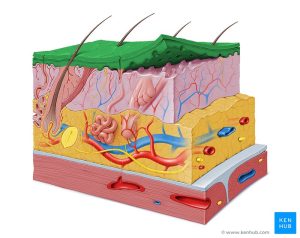Integumentary (Skin) System – outline notes
Call Us Now
Get the Best CPR Class in St. Louis Today!

I. Integumentary System
A. Skin
1. Epidermis
2. Dermis
B. Appendages
1. Hair
2. Nails
3. Cutaneous (skin) Glands
II. Skin
A. Epidermis
1. Functions
a. Barrier tissue in first line of defense
b. Mechanical barrier – resists bacteria, water, etc.
1) Substances that can enter readily
-lipid soluble substances – steroids
-organic solvents – acetone, paint thinner
-heavy metals – lead, mercury, nickel
c. Chemical barrier
1) Low pH (acid mantle) decreases bacterial growth,
melanin (UV radiation)
2) Biological barrier – Langerhans cells
d. Production of vitamin D3 (cholecalciferol)
1) Sunlight stimulates keratinocytes to produce vitamin D3
2) Liver converts D3 to product that kidneys use to make
calcitriol
3) Calcitriol is essential for normal absorption of Calcium
(Ca2+) and Phosphate (PO43-) at small intestines
4) Milk is fortified with vitamin D (normal bones)
2. Structure
a. Stratified squamous epithelium
b. Cells
1) Keratinocytes
–most abundant
-produces keratin (tough, water-resistant protein)
2) Melanocytes
-produce melanin
3) Langerhans cells
-defense
4) Merkel cells
-sensitive touch receptors
3. Five layers of the epidermis (thick skin – palmar & plantar regions)
**Deep to Superficial
a. Stratum Basale (Germinativum)
1) Single layer of Basal cells (mitotic cells)
2) Epidermal ridges – extend into dermis (fingerprints)
3) Dermal papillae – b/t epidermal ridges
4) Melanocytes
5) Merkel cells
b. Stratum Spinosum
1) 8-10 cells thick
2) Actually are basal cells that were pushed up
3) Langerhans cells
c. Stratum Granulosum
1) 3-5 cells thick
2) Dark staining, grainy layer
3) Dells stop dividing
4) Keratinocytes produce large amounts keratin
5) Cells die, membraneous bags of keratin
d. Stratum Lucidum
1) 3-5 cells thick
2) Only in thick skin
3) Dead keratinocytes
e. Stratum Corneum
1) 15-30 cells thick, 75% of epidermal thickness
2) Constantly sloughing off
3) New epidermis every 35-45 days
B. Dermis
1. Functions
a. Very vascular – vents heat and nourishes avascular epidermis
b. Gives skin its strength
2. Structure
a. Collagen and elastic fibers
b. Cells
1) Fibroblasts, macrophages, mast cells, etc
c. Composed of two layers
1) Papillary layer – dermal papillae attach to above
epidermis
-Areolar loose C.T.
-Capillary network – allows heat to radiate off of body
-Meissners corpuscles – fine touch, pressure
receptors
-Capillary hemangioma – birthmark; tumor of
capillaries in papillary layer; generally fades
2) Reticular layer – deepest skin layer
-Dense irregular C.T.
-Arteries, veins, sweat and sebaceous glands, hair
follicles, lymphatics, nerves
-Pacinian corpuscles – deep pressure receptors
-Leather when tanned
-80% of dermis thickness
-Stretch marks – extreme stretching of dermis
-Blister – w/in epidermis or b/t dermis and epidermis
-Wrinkles – decreased amount of elastin (age, UV
radiation)
-Cavernous hemangioma – “port-wine stain”;
birthmark; tumor of larger vessels in dermis;
lasts lifetime
-Decubitis ulcers – bedsores; circulatory restrictions;
kills epidermal cells; leads to bacterial infection; dermis deteriorates
-Necrosis – tissue dies due to inadequate blood
supply
C. Skin Color
1. Three pigments
a. Melanin
1) Brown, reddish-brown, to black pigment
2) Produced by melanocytes (stratum basale) from
amino acid tyrosine
3) Packaged in melanosomes and transferred to
keratinocytes
4) Protection from UV radiation, suntan
-albinism – no melanin produced
-freckles
b. Carotene
1) Orange-yellow pigment; accumulates in epidermis
2) Carrots / squashes
3) Soles and palms
4) Converted to vitamin A (required for photoreceptor
pigments in eye)
c. Hemoglobin (Hb)
1) Red pigment
2) w/ O2 – bright red; Hb w/out O2 – dark red
3. Cyanosis – bluish-coloration from sustained reduction
of dermal circulation
III. Hypodermis (Subcutaneous or Superficial Fascia)
A. Not part of skin
B. Attaches skin to muscle; also allows movement
C. Loose C.T. w/ adipocytes
D. Accumulate subcutaneous fat (men and women different distribution)
IV. Appendages
A. Epidermal derivatives – all derived from epidermis
B. Types — Cutaneous glands, hair, nails
C. Cutaneous glands
1. Located in Dermis
2. Sweat glands (Sudoriferous)
a. Merocrine (Eccrine) sweat glands
1) Open into pores (epithelial openings)
2) All over body; palms
3) Water (99%), NaCl, organic wastes(urea)
4) Cools skin
5) Regulated by sympathetic nervous system (SNS)
b. Apocrine sweat glands
1) Axillary and anogenital areas
2) Ducts open into hair follicles
3) Fatty acids and proteins; good nutrient for bacteria
4) Larger than eccrine glands
5) Myoepithelial cells squeeze gland; discharge
6) Analoguous to sexual scent glands of animals (increase in
activity during sexual foreplay and enlarge and recede with menses)
3. Sebaceous (oil) glands / (Holocrine glands)
a. Release sebum into hair follicles (associated with hair follicles)
b. Moisturize hair and skin; bactericidal action
c. Very active during puberty – high levels of sex hormones
1) Pimples
4. Other glands of integument
a. Mammary glands
1) Modified sweat gland
b. Ceruminous glands
1) Modified sweat gland
2) Cerumen – ear wax
D. Hair
1. Everywhere except
a. Soles, palms, lips, portions of external genitalia
2. Epithelial structures that grow from organs called hair follicles
3. Cross section reveals medulla, cortex, cuticle
4. Arrector pili – smooth muscle hair follicle to papillary layer of dermis
a. Goose bumps
E. Nails – modified epidermis
Call Us Now
Get the Best CPR Class in St. Louis Today!






